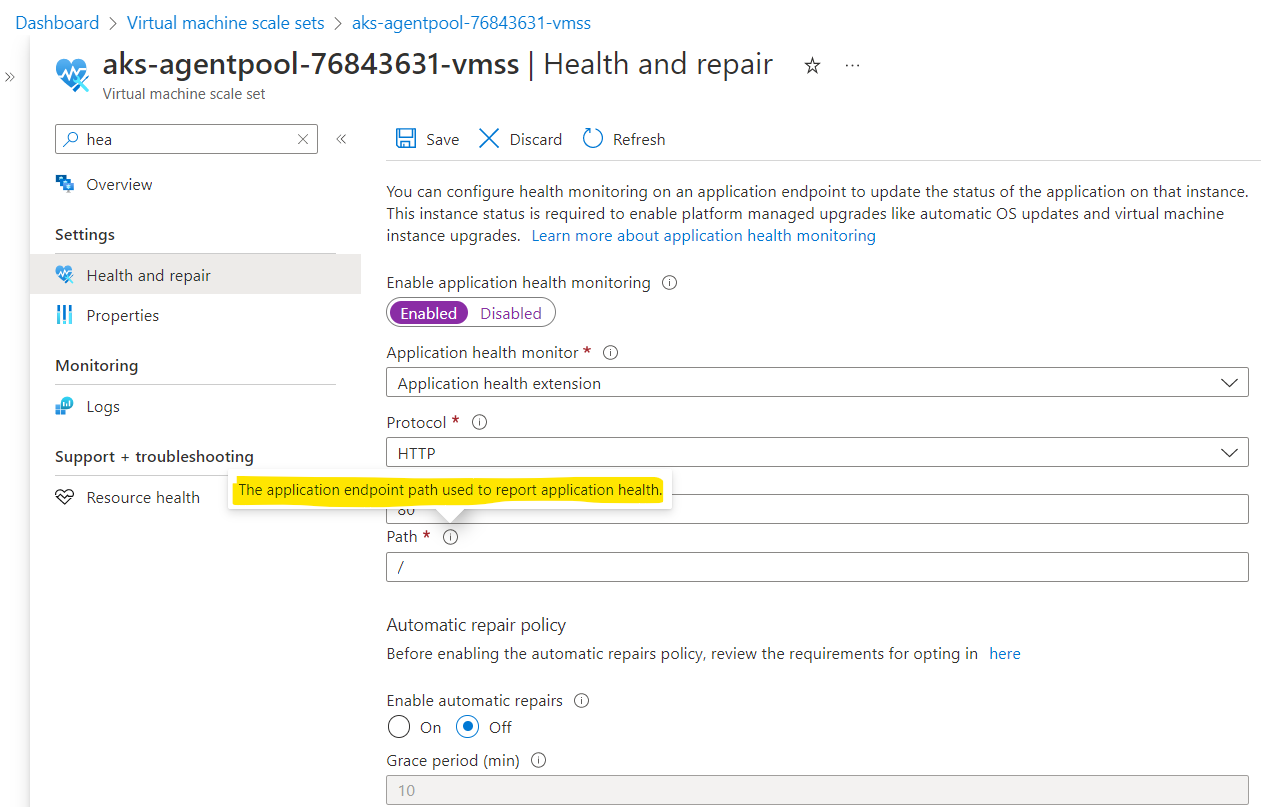Cannot enable autorepair for VM scale set
I'm not able to enable autorepair for my VM scale set configured via Terraform or manually via Azure Portal. Despite having automatic_instance_repair and health_probe_id the autorepair is still disabled in "Health and repair" tab. I've also tried to add it manually in Azure Portal but it doesn't allow me to assign a load balancer rule, either the one created by Terraform or another one created manually. Load balancer probe is just grayed out in the dropdown.

I've also tried to work around it by configuring a healthcheck extension. Unfortunately, it complains that the VMs cannot have both the probe and extension configured. Healthchecks work fine for the instances, only autorepair can't be enabled. Am I missing something here?
Here is the complete Terraform script:
variable "vm_password" {
description = "Linux virtual machine root password"
type = string
sensitive = true
}
variable "frontend_ip_configuration_name" {
description = "Frontend IP configuration name referenced by the load balancer"
type = string
default = "example-frontend-ip"
}
# Azure Provider source and version being used
terraform {
required_providers {
azurerm = {
source = "hashicorp/azurerm"
version = "=3.0.0"
}
}
}
# Configure the Microsoft Azure Provider
provider "azurerm" {
features {}
}
# Configure a resource group
#
# All Azure resources have to be part of a resource group.
resource "azurerm_resource_group" "example" {
name = "example-resource-group"
location = "UAE North"
}
# Configure a VM scale set
resource "azurerm_linux_virtual_machine_scale_set" "example" {
admin_username = "exampleadmin"
admin_password = var.vm_password
disable_password_authentication = false # Use password auth instead of SSH keys
instances = 2 # Default number of instances
location = azurerm_resource_group.example.location
name = "example-linux-virtual-machine-scale-set"
resource_group_name = azurerm_resource_group.example.name
sku = "Standard_B1ls" # Smallest VM for testing purposes
network_interface {
name = "example-network-interface"
primary = true
ip_configuration {
name = "internal"
subnet_id = azurerm_subnet.example.id
load_balancer_backend_address_pool_ids = [
azurerm_lb_backend_address_pool.example.id
]
}
}
os_disk {
caching = "None"
storage_account_type = "Standard_LRS" # Lowest storage tier
}
# Find available images in region with command 'az vm image list' eg.
# az vm image list --publisher "Canonical" --offer "Ubuntu" --sku "20_04-lts" --location "UAE North" --all
source_image_reference {
offer = "0001-com-ubuntu-server-focal"
publisher = "Canonical"
sku = "20_04-lts"
version = "latest"
}
custom_data = filebase64("start_web_server.sh") # Base64 encoded startup script
# For some reason this currently does not enable self-healing
automatic_instance_repair {
enabled = true
grace_period = "PT10M"
}
health_probe_id = azurerm_lb_probe.example.id # Healthcheck used to determine if instance is healthy
}
# Configure a subnet
resource "azurerm_subnet" "example" {
name = "example-subnet"
resource_group_name = azurerm_resource_group.example.name
virtual_network_name = azurerm_virtual_network.example.name
address_prefixes = ["10.0.0.0/24"] # Occupied part of the address space (10.0.0.0 - 10.0.0.255)
}
# Configure a virtual network
resource "azurerm_virtual_network" "example" {
address_space = ["10.0.0.0/16"] # Address spaces available for subnets (10.0.0.0 - 10.0.255.255)
location = azurerm_resource_group.example.location
name = "example-virtual-network"
resource_group_name = azurerm_resource_group.example.name
}
# Configure a load balancer
resource "azurerm_lb" "example" {
location = azurerm_resource_group.example.location
name = "example-lb"
resource_group_name = azurerm_resource_group.example.name
frontend_ip_configuration {
name = var.frontend_ip_configuration_name
public_ip_address_id = azurerm_public_ip.example.id
}
}
# Configure a public IP
resource "azurerm_public_ip" "example" {
allocation_method = "Dynamic"
location = azurerm_resource_group.example.location
name = "example-public-ip"
resource_group_name = azurerm_resource_group.example.name
}
# Configure a backend address pool
#
# This pool manages IPs that will be accessed by the load balancer.
resource "azurerm_lb_backend_address_pool" "example" {
loadbalancer_id = azurerm_lb.example.id
name = "example-backend-address-pool"
}
# Configure a load balancer rule
#
# This rule tells which ports should be used on load balancer and VMs.
resource "azurerm_lb_rule" "example" {
backend_port = 8080 # Port of application on the VM
frontend_ip_configuration_name = var.frontend_ip_configuration_name
frontend_port = 80 # Port on which load balancer will receive requests
loadbalancer_id = azurerm_lb.example.id
name = "example-lb-rule"
protocol = "Tcp"
backend_address_pool_ids = [
azurerm_lb_backend_address_pool.example.id
]
probe_id = azurerm_lb_probe.example.id # Healthcheck used to determine if instance is healthy
}
# Configure a healthcheck probe
resource "azurerm_lb_probe" "example" {
loadbalancer_id = azurerm_lb.example.id
name = "example-lb-probe"
port = 8080
protocol = "Http"
request_path = "/"
}
# Output variables printed to the console after apply
output "lb_public_ip" {
description = "Public IP address of the load balancer"
value = azurerm_public_ip.example.ip_address
}

